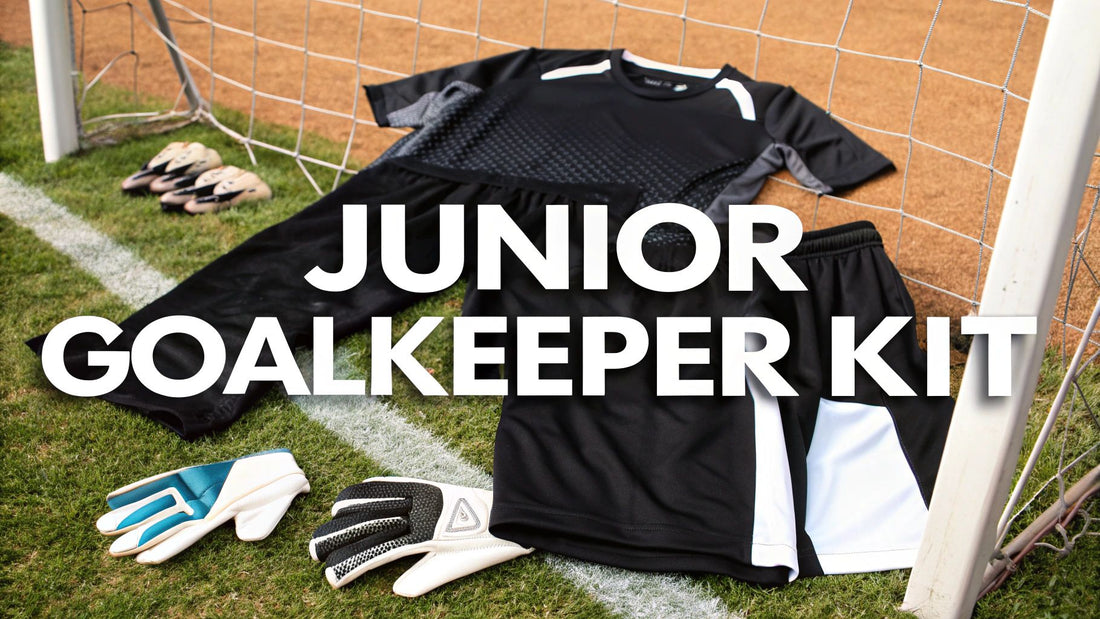Equipping a young goalkeeper is a different ball game compared to buying kit for an outfield player. A keeper's gear is their armour, and every piece is designed with one goal in mind: giving them the confidence to be brave, dive hard, and command their box without hesitation.
Getting the kit right is the first step towards building a solid, confident presence between the posts.
Your Essential Junior Goalkeeper Kit Checklist
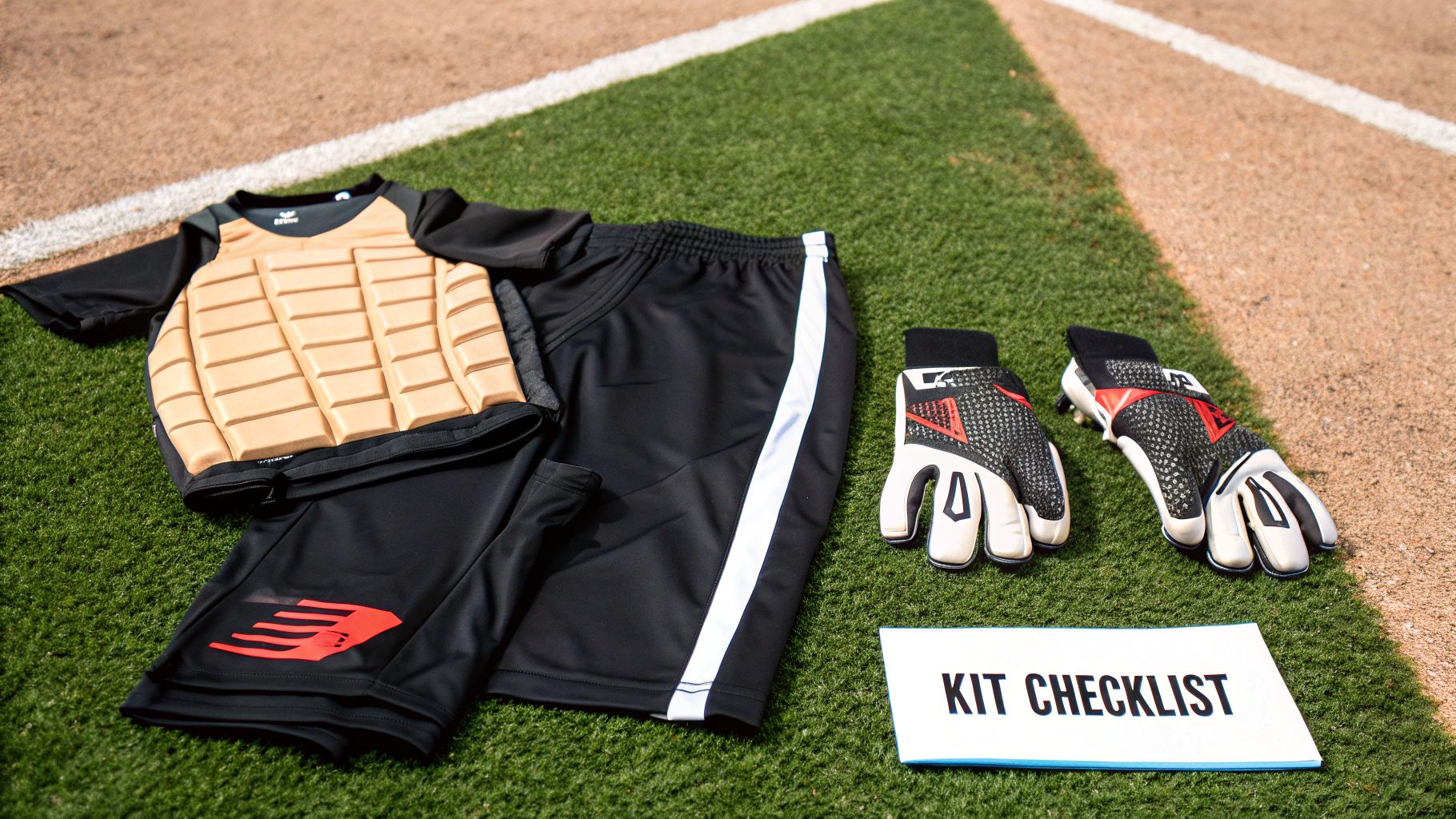
Unlike their teammates, a goalkeeper's kit is all about protection. It is built to handle the unique, high-impact demands of the position—diving, blocking shots, and commanding the penalty area. Each item serves a specific purpose, blending safety with the agility needed for those split-second saves.
A well-chosen junior goalkeeper kit does more than just prevent scrapes and bruises; it empowers a young keeper to play without hesitation. When they feel secure, they can stop worrying about hitting the ground and focus completely on stopping the ball.
The Non-Negotiable Components
Here is a breakdown of the core items that every young keeper needs. Think of this as the foundation for a safe and successful season in goal.
- Padded Goalkeeper Jersey: This is their first line of defence against hard ground and stinging shots. Look for lightweight padding on the elbows and sometimes shoulders. This cushions the impact from the hundreds of dives they'll make over a season.
- Goalkeeper Shorts or Trousers: These are not standard football shorts. They must have padding on the hips and outer thighs—the exact spots that take a beating during a diving save.
- Goalkeeper Gloves: This is perhaps the most crucial piece of their equipment. Good gloves provide the grip needed to hang onto the ball and vital protection for their hands and fingers when facing powerful shots.
- Football Socks: You'll need long socks to pull up over their shin guards, holding them securely in place while adding an extra layer of support and protection for their lower legs.
This gear is designed to work together as a complete system. If you're looking for more general advice on player apparel, our guide on choosing a kids' football training kit has some great complementary tips.
Junior Goalkeeper Kit Components at a Glance
To make it even simpler, here is a quick summary of what you need and what to look for when you're buying.
| Kit Component | Primary Purpose | Key Features to Check |
|---|---|---|
| Padded Jersey | Cushions impact from diving | Lightweight padding on elbows and shoulders; breathable fabric |
| Shorts/Trousers | Protects hips and thighs | Durable material with integrated hip and outer leg padding |
| Goalkeeper Gloves | Grip and hand protection | Good latex palm for grip; finger protection (optional); secure wrist strap |
| Football Socks | Holds shin guards; support | Long enough to cover shin guards; good elasticity |
Getting these basics right from the start means your young keeper can step onto the pitch feeling protected, looking the part, and ready to make that match-winning save.
Why a Goalkeeper Kit Is Not Just a Regular Kit
Ever wondered why a goalie's gear looks so different from everyone else's on the pitch? It is not just a fashion statement. Think of a junior goalkeeper kit as a footballer's version of armour, built for a unique and demanding role. It is not just about wearing a different colour; it is about having specialised protection for a high-impact job.
Where an outfield player’s kit is designed to be as light as possible for sprinting, a keeper's gear is made for diving, sliding, and blocking shots. This means key areas are reinforced to absorb knocks, allowing a young keeper to play confidently and without fear.
Built for Protection, Not Just Performance
The biggest difference comes down to one thing: built-in padding. An outfield player does not need extra cushioning, but for a goalkeeper, it is non-negotiable. Modern materials are cleverly engineered to be protective without being bulky, ensuring young players stay agile and quick on their feet.
This infographic breaks down the basic equipment differences at a glance.
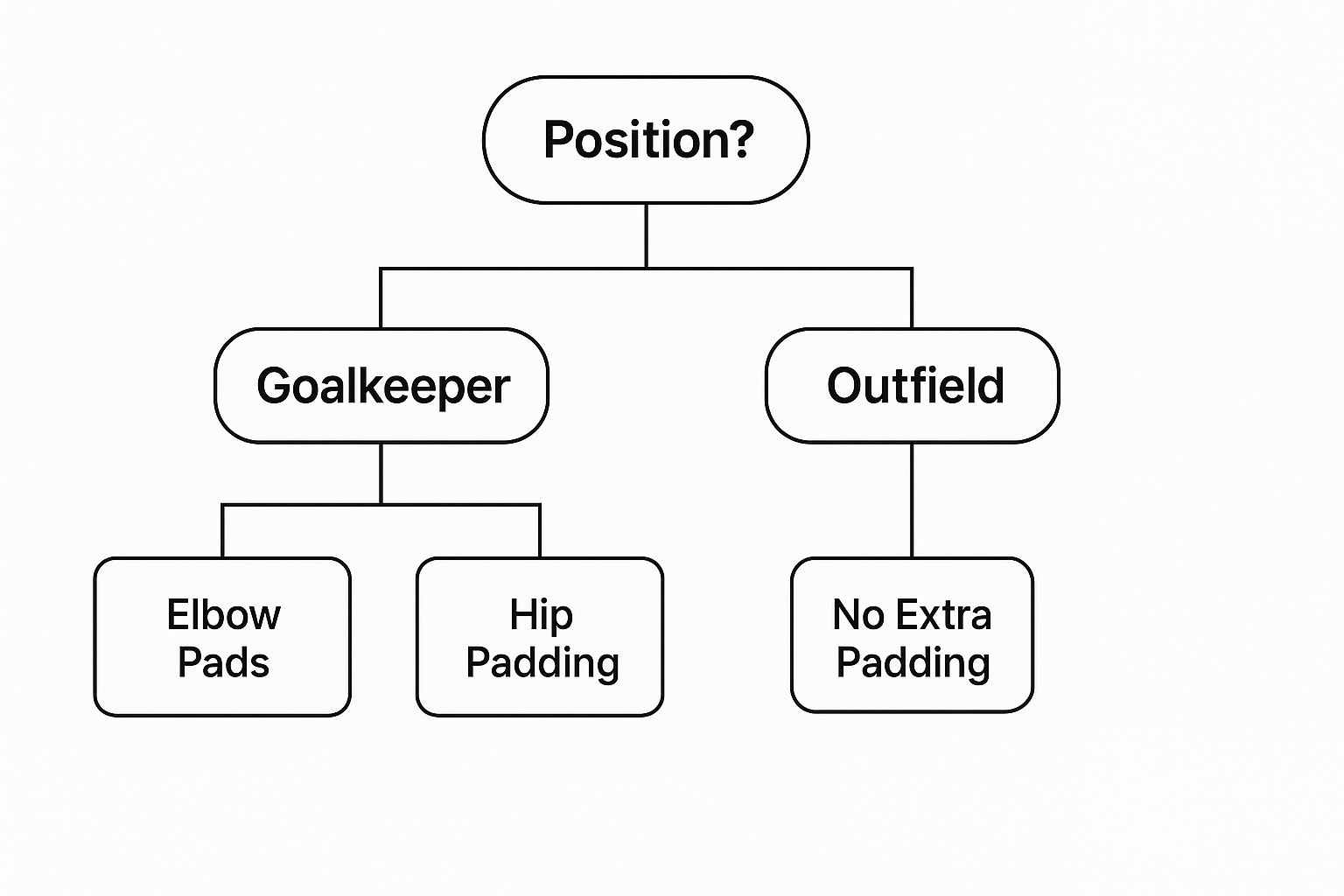
As you can see, that protective padding is the defining feature that sets a keeper’s gear apart from a standard outfield kit.
Every single piece is designed with a goalkeeper's actions in mind. Let’s break it down:
- Padded Jersey: This is not your average football shirt. A keeper's jersey often has lightweight foam padding stitched into the elbows to cushion the impact from repeated dives on hard or dry ground.
- Padded Shorts: In the same way, goalkeeper shorts come with padding on the hips. This is a game-saver, protecting the hip bones and upper thighs when a keeper launches themselves sideways to smother a powerful shot.
- Specialised Gloves: Gloves are a goalkeeper’s most important tool, hands down. They provide the crucial grip needed to catch the ball and protect the fingers from stinging shots—something no other player gets to use.
A well-designed goalkeeper kit has a direct impact on a player’s confidence. When a young keeper trusts that their gear will absorb the blow of a dive, they’re far more likely to commit fully to making that save.
Here in the UK, affordability is a huge factor in the junior goalkeeper kit market, with brands like KIPSTA offering fantastic, cost-effective options. These kits deliver all the essential protective gear, from padded jerseys to durable shorts, making the position accessible for any young player who wants to give it a go. Find out more about choosing the right goalkeeping kit for your junior player on soccerwares.com. Ultimately, this focus on safety and accessibility is what helps nurture the next generation of keepers.
Selecting Goalkeeper Gloves for Young Hands
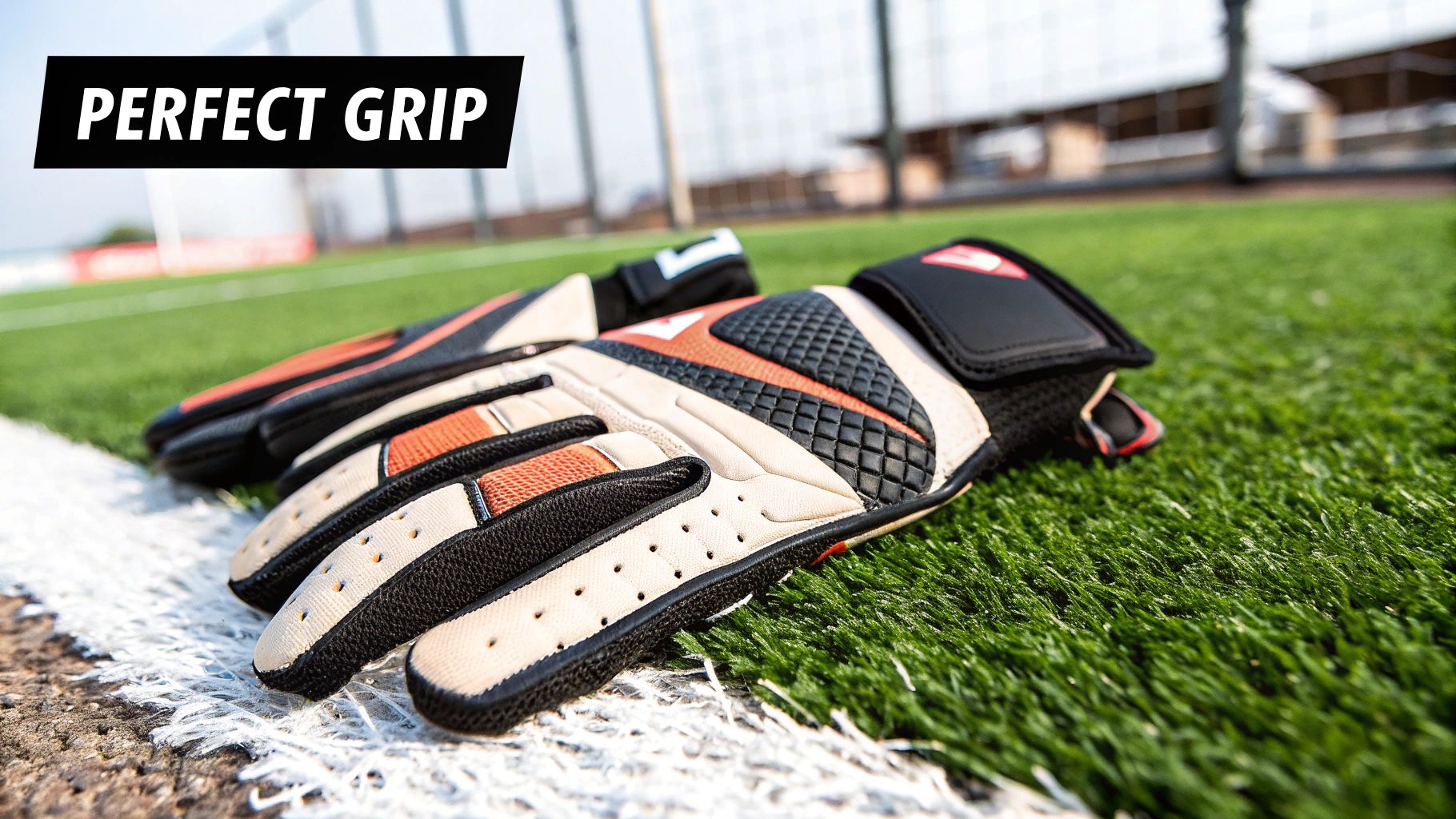
For a goalkeeper, their gloves are everything. They are not just for protection; they're the single most important tool for catching, punching, and controlling the ball. But if you are buying for a junior player, the sheer choice of different cuts, features, and materials can feel a bit overwhelming.
Let's break it down. The first thing to get your head around is the 'cut' of the glove. Think of the cut as the way the palm material is stitched to the backhand – it completely changes how the glove fits and feels.
Understanding Glove Cuts
Each cut has its own pros and cons, and honestly, the best choice often just comes down to what feels right for the young keeper. Here are the most common styles you'll come across when looking for a goalkeeper kit junior:
- Flat Palm: This is the classic, traditional cut. It offers a slightly looser fit and a large, flat surface area to make contact with the ball, making it a brilliant starting point for beginners.
- Roll Finger: As the name suggests, the latex palm material "rolls" around the fingers in this style. This creates a much snugger fit and fantastic latex-to-ball contact, which is a massive help for grip.
- Negative Cut: With a negative cut, the stitching is on the inside of the glove. This gives the tightest, most streamlined fit possible, offering a superb "feel" for the ball. It is often the cut that players graduate to as their handling skills improve.
To Protect or Not to Protect
Another huge consideration is finger protection, often called "fingersaves". These are small plastic spines that sit inside the fingers of the glove, designed to stop them from bending backwards when facing a powerful shot.
For very young beginners, these can sometimes be a bit too rigid and can actually get in the way of learning how to shape their hands properly for a catch. On the other hand, for a player who has had a finger injury before or is just stepping up to a level with harder shots, they provide a priceless layer of safety and confidence. It really depends on the individual player.
For a young player, the right fit is more important than any other feature. A glove that is too big will feel clumsy and reduce ball control, while one that is too small will be uncomfortable and could wear out faster.
Here in the UK, the youth football scene really focuses on designs that strike a good balance between protection and comfort. You will find that junior gloves often use lightweight materials to encourage proper hand positioning while still packing in features to reduce the risk of injury. This focus has pushed many parents to shop online, where comparing brands and models is much easier.
Do not forget about the cold! Keeping hands warm is crucial for performance and comfort during those winter months. You can find some great advice in our guide on heated football gloves and training wear.
Getting the Perfect Fit for Goalkeeper Apparel
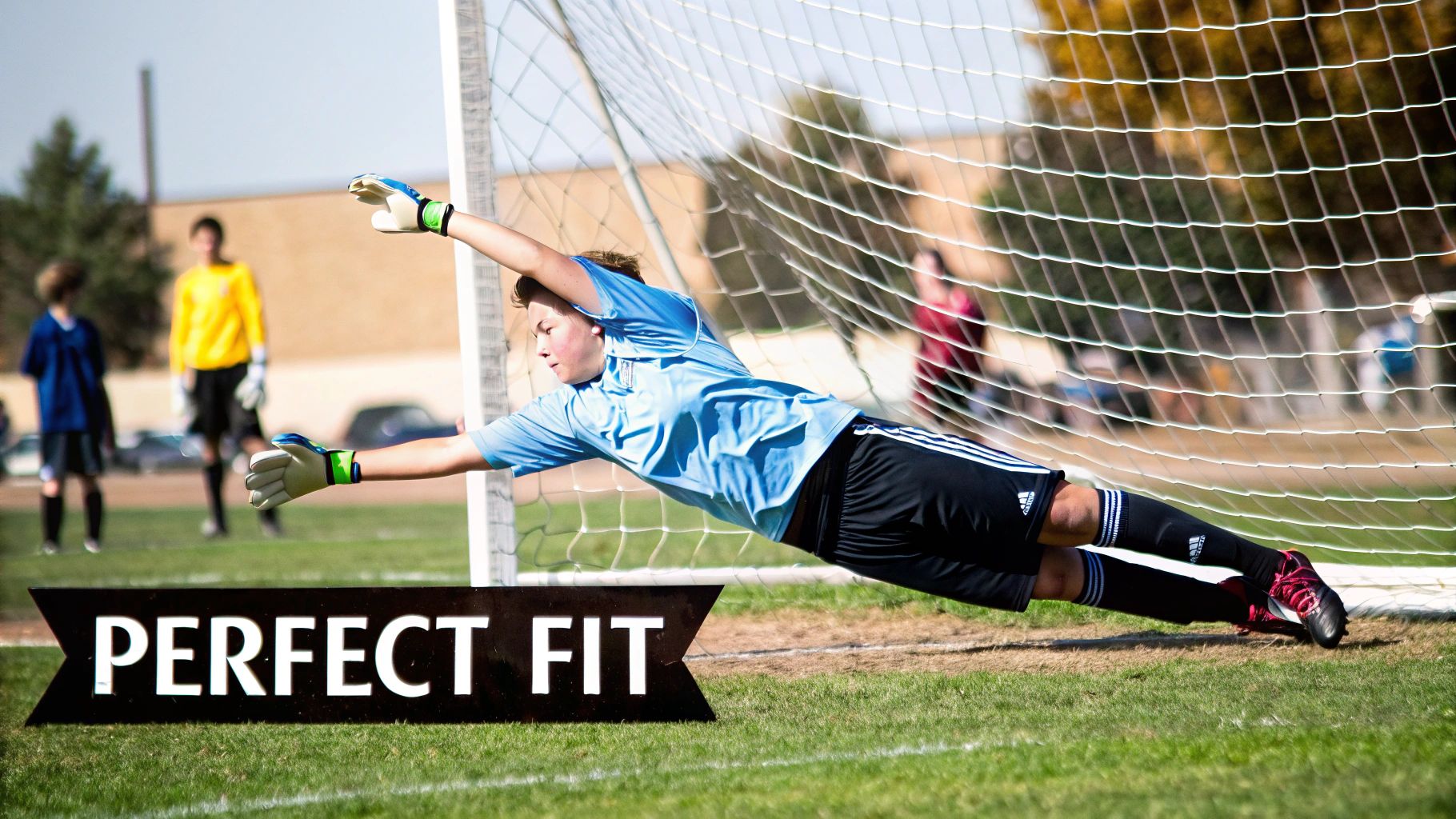
Getting the sizing right for a goalkeeper kit junior is a tricky balancing act. If the jersey is too tight, it will restrict your keeper's reach for catches and throws. But if the shorts are too loose, they can get tangled up during a crucial dive.
The sweet spot is a fit that offers protection without getting in the way of agility. It needs to be snug enough to hold padding in place but with enough room for explosive movements. Think of it like a second skin, not a restrictive shell or a baggy distraction.
To Grow or Not to Grow
It is tempting to buy a size up for your child to ‘grow into,’ but for goalkeeping gear, this can backfire.
- Loose Jerseys: Padding on the elbows can easily slip out of place, offering zero protection right when it is needed most.
- Baggy Shorts: Excess material bunches up, and oversized hip pads will not sit correctly to absorb the impact from a save.
The best approach is always to prioritise a proper fit for the current season. A well-fitting kit provides optimal protection and allows for a full range of motion—two things that directly boost performance and confidence on the pitch.
Measuring for Success
Do not just rely on standard age sizing. We all know children grow at different rates, and one brand's 'Age 10' can be wildly different from another's. Always grab a tape measure and check the specific brand’s size chart before you buy.
To get the most accurate fit for a jersey and shorts, you should measure:
- Chest: Measure around the fullest part of their chest, keeping the tape measure flat and level.
- Waist: Measure around their natural waistline, which is usually just above the hips.
- Height: This is a great final check to confirm the overall length of the jersey and trousers.
This focus on a good fit applies to all of a player's gear, not just the keeper kit. For some broader advice, check out our tips on choosing the right football training wear to go with their match day kit.
Choosing Materials That Last the Season
Goalkeepers are tough on their gear. From muddy dives on a wet Saturday morning to abrasive slides on an artificial pitch, their kit takes a constant beating. Picking the right materials is the key to investing in a goalkeeper kit junior that will see them through the whole season, not just a handful of matches.
The fabric of the jersey and shorts plays a massive part in both comfort and how long the kit lasts. Most modern kits you'll find are made from polyester or a polyester blend. This isn't just about keeping costs down; polyester is brilliant at wicking moisture away from the skin, which keeps young keepers dry, comfortable, and focused on the game.
Think of it like this: a standard cotton t-shirt just soaks up sweat and gets heavy and clingy. A proper moisture-wicking jersey, on the other hand, pulls that perspiration to the surface where it can evaporate. It's a small technical detail that makes a huge difference to performance during a tough match.
Spotting a Quality Kit
Beyond the main fabric, it is the little details that often reveal how well a kit is made. You need to look for signs of quality construction that show it is built to handle the specific demands of being a goalkeeper.
Here are a few key things to check for:
- Reinforced Stitching: Have a close look at the seams, especially around high-impact areas like the shoulders and under the arms. Double stitching here is a great sign of a durable garment that will not fall apart after a few rough-and-tumble games.
- Robust Padding: The foam padding on the elbows, hips, and knees should feel substantial but still flexible. It needs to absorb impact properly without being so stiff that it gets in the way of their movement.
- Abrasion-Resistant Panels: Some better kits include tougher, more textured panels on the forearms and hips. These are designed specifically to resist scrapes and scuffs from hard ground.
A well-made kit is a smart investment. It doesn't just offer better protection; it also holds its shape and integrity after countless washes, saving you from having to buy a mid-season replacement.
The UK football merchandise market, which includes junior goalkeeper kits, sees steady demand year-on-year, driven by massive youth participation rates. This consistent interest pushes manufacturers to produce durable, specialised gear that really meets the needs of young players. To get a better feel for this, you can explore the latest insights into the UK's soccer merchandise market. Investing in a kit with quality materials ensures your young keeper is properly kitted out for a whole season of saves.
Got Questions About Your Junior Goalkeeper Kit? We Have Answers
Choosing the right kit for a young goalkeeper throws up a lot of questions. When should you replace worn-out gloves? What's the best way to wash everything so it lasts? Getting straight answers helps you buy with confidence.
Think of this as your quick guide to the practical stuff. We have rounded up the most common queries we hear from parents and young players to give you straightforward advice.
How Often Should We Replace Goalkeeper Gloves?
Honestly, it all comes down to how much they are used, the quality of the latex, and what kind of pitch they play on. For a child training once or twice a week on grass, a good pair might just about last a full season. But if they're playing on abrasive 3G pitches, that soft latex palm will wear down much, much faster.
Keep a close eye on the palms. Once the grip is obviously gone or bits of foam are peeling away, it is time for a new pair. It is a matter of safety as much as performance.
Here's a great tip: have two pairs of gloves. Use an older, more worn pair for training sessions and save the fresh, grippy pair for match days. It makes the good ones last so much longer.
Padded Shorts vs. Three-Quarter Length Trousers?
This one usually boils down to personal preference and playing conditions. Each style has its own clear benefits for a young keeper.
- Padded Shorts: These are fantastic for warmer weather. They protect the hips where keepers land most often but leave the knees free, which is great for staying cool.
- Three-Quarter Trousers: Often called 'keeper pants', these give you padding on both the hips and the knees. They're an absolute lifesaver on hard ground or artificial turf, saving your keeper from nasty scrapes and grazes.
Chat with your child about what they find comfortable, but also think about the weather and the pitches they play on most.
Are Expensive Branded Kits Really Better?
Not always, especially for young players who are growing rapidly. While the top brands use impressive tech and materials, there are plenty of affordable brands out there making fantastic gear that is perfect for grassroots football.
The most important things are a proper fit, genuine comfort, and decent padding in the right places. A durable, well-fitting kit from a budget-friendly brand is often a much smarter buy for a child who is still figuring out if being a keeper is their long-term passion.
How Do I Care for the Kit to Make It Last?
Good question! Looking after the kit properly is the secret to getting your money's worth. For the jersey and shorts, always wash them inside out on a cool cycle—just follow the instructions on the label. A big one to remember is to avoid fabric softener, as it can clog up the material and ruin its ability to wick sweat away.
Gloves need a bit more love. Get into the habit of cleaning them after every single use with lukewarm water and a proper glove wash to keep the latex from drying out. Never, ever wring them out. Just gently squeeze the extra water out and let them air dry somewhere away from radiators or direct sunlight, which will make the latex brittle and useless.
Ready to find the perfect gear for your young shot-stopper? SoccerWares offers a fantastic range of high-quality football training essentials and fan merchandise to support players at every level. Explore our collection and get your keeper kitted out with confidence.
Find everything you need at https://soccerwares.com.

